
Please click on the evolution of the Broncos uniform poster above for a close-up version of the poster. The descriptions below give you some insight and background about the uniforms and/or eras depicted in the poster.
Fall 2021: To purchase a reasonably priced 8" x 24" plaqued mounted version of the Broncos poster that's ready to hang on your wall, please visit Heritage Sports Stuff.
1960
One mile above sea level, the Denver Broncos were created in 1960. Joining the AFL as charter members as well, were the New York Titans (now Jets); Dallas Texans (now Kansas City Chiefs); Los Angeles Chargers (now San Diego Chargers); Houston Oilers (now Tennessee Titans); Boston Patriots (now New England Patriots); Buffalo Bills; and Oakland Raiders.
The name Broncos’ was adopted after a baseball team that had once played in Denver (Denver’s 1921 Midwest Baseball League team was apparently also called the Broncos). The Broncos’, outfitted in what most consider to be the ugliest uniforms of all time (especially with the vertically-striped socks shown in this painting) ventured forth into its first season of professional football. Despite losing its first 5 exhibition games, the team managed to become the first AFL club with a regular season victory (a September 9, 1960 13-10 victory over the Boston Patriots). This glimmer of hope would soon fade as the club finished 4-9-1 and thus began 13 straight years of sub .500 football. In fact, the 1960’s Broncos would finish the decade with a frightening 39-97-4 record, the worst of any of the original eight AFL teams.
We decided to showcase the ENTIRE ’60 uniform so football enthusiasts could see the striping pattern on the socks. General Manager, Dean Griffing, bought the uniforms from the defunct ‘Copper Bowl’ which was held in Tucson, Arizona. After finishing the ’61 season with a disappointing 3-11, the Broncos’ second head coach, Jack Faulkner, made it a priority to gas these abominations! A public uniform burning session took place, resulting in an interesting circumstance – there are now precious few pictures of the uniforms still existing today, let alone actual jerseys and socks.
-------------------------------------------------------------------------------------------------
1963
With the yellow & brown uniforms now a bitter memory, Coach Faulkner went out, and purchased orange uniforms which eventually lead to ‘orange mania’. Ironically, Faulkner was under the impression the uniforms were going to be ‘burnt orange’, similar to the Cleveland Browns. Instead, the manufacturer sent bright orange. This familiar color would remain a Broncos staple, well into the 90’s! Note the striping pattern on the ’63 jersey – three white stripes, and the ‘bucking bronco’ logo on the helmet.
After posting a respectable 7-7 season record in 1962, the Broncos’ took a step backwards in 1963 recording the first of two consecutive 2-11-1 seasons. Of note, both 1963 wins came at home in Mile High Stadium.
-------------------------------------------------------------------------------------------------
1965
The ’65 jersey features some interesting modifications: a thick, blue stripe has now been added to both sleeves with the players’ number nestled inside the striping pattern. If you look closely, you’ll also notice a thin, blue trim around the white numbers on the front of the jersey, and the addition of a white collar.
An interesting note about 1965: The AFL began in 1960 as an 8 team rival league to the NFL. Both leagues competed head to head for players, fans and broadcast revenue. This was the way it was from 1960 to 1965 - two separate leagues, two separate champions (although few people would have honestly believed that the AFL champion could have beaten the NFL champs). Then in 1965 the two leagues agreed to merge. It was decided that beginning in 1970 there would be only one league, the NFL. In the interim, between 1966 and 1969, the AFL Champion would play the NFL Champion for the “World Championship”. It was only after the first World Championship had been played in 1966 that the name “Super Bowl” came into being. Thus the 1965 season was the last season there was an AFL Champion that didn’t go on to compete against the NFL Champs but that really didn’t matter to 1965’s 4-10 Broncos who missed post-season play for the 6th straight year.
Did you know? The Broncos came within a whisker of leaving Denver. In 1965, several minority partners formed a majority and voted to sell the Broncos to a group who wanted to move the team to Atlanta. At the last minute, Gerald and Allan Phipps, who had been left out of the voting block, bought the team. Excited fans showed their appreciation by purchasing almost 23,000 season tickets, compared to fewer than 8,000 the year before all this in spite of the team’s dismal record in their first 6 years of existence.
With respect to the AFL-NFL Championship game, here’s what happened between 1966 and 1969: The 1966 season saw the first meeting of the AFL and NFL champions, with the NFL Champion Green Bay Packers humbling the AFL’s KC Chiefs 33-10. (Even though the game was played in 1967, most football historians refer to this as the 1966 Super Bowl because it was the culmination of the 1966 season.) The NFL superiority was on display again in 1967, when the NFL’s Packers pounded the AFL’s Raiders 33-14. Then came 1968 and the stunning upset - the AFL’s NY Jets shocked the football world by beating the NFL’s heavily favored Baltimore Colts 16-7.
Thus the stage was set for the Super Bowl IV, the last meeting between the AFL and NFL Champions, and once again the AFL triumphed, evening the series at two wins apiece, as the AFL’s Kansas City Chiefs whacked the NFL’s Minnesota Vikings 23-7.
One final AFL-NFL note: In 1967 the Broncos did set one AFL-NFL record – they were the first AFL team to beat an NFL team, beating the Detroit Lions, 13-7 on August 5, 1967.
-------------------------------------------------------------------------------------------------
1968
By 1968, the infamous capital ‘D’ and fierce-looking bronco have become the official Broncos’ logo. Notably, the helmet color was switched from orange to blue with an orange stripe down the center. Finally, the sleeves were changed from a thick blue stripe bearing the player’s number to a single, thin, white stripe.
Some interesting notes to the years 1966-1969: The AFL began in 1960 as an 8 team rival league to the NFL. Both leagues competed head to head for players, fans and broadcast revenue. This was the way for 5 years, two separate leagues, two separate champions (although few people would have honestly believed that the AFL champion could have beaten the NFL champs). Then in 1965 the two leagues agreed to merge. It was decided that beginning in 1970 there would be only one league, the NFL, and that between 1966 and 1969 the AFL Champion would play the NFL Champion for the “World Championship”. It was only after the first World Championship had been played in 1966 that the name “Super Bowl” came into being. Thus in 1968 the AFL Broncos were competing for two titles, the AFL Championship and the Super Bowl
Championship. It was not to be though, as the Broncos went 5-9 on the season, and
finished 4th in the AFL and out of the playoffs for the 9th straight year.
With respect to the AFL-NFL Championship game, here’s what happened between 1966 and 1969: The 1966 season saw the first meeting of the AFL and NFL champions, with the NFL Champion Green Bay Packers humbling the AFL’s KC Chiefs 33-10. (Even though the game was played in 1967, most football historians refer to this as the 1966 Super Bowl because it was the culmination of the 1966 season.) The NFL superiority was on display again in 1967, when the NFL’s Packers pounded the AFL’s Raiders 33-14. Then came 1968 and the stunning upset - the AFL’s NY Jets shocked the football world by beating the NFL’s heavily favored Baltimore Colts 16-7.
Thus the stage was set for the Super Bowl IV, the last meeting between the AFL and NFL Champions, and once again the AFL triumphed, evening the series at two wins apiece, as the AFL’s Kansas City Chiefs whacked the NFL’s Minnesota Vikings 23-7.
-------------------------------------------------------------------------------------------------
1971
The Broncos are now in the NFL – after the AFL officially merged with the NFL for the 1970 season. And though the road uniform showcased here highlights a few nice differences from past seasons, such as the coloured striping patterns on the sleeves & the pants converting from white to orange, the Broncos would still struggle to reach the .500 football plateau, finishing 4-9-1 in 1971. All the while, Denver fans stood by their team, selling out Mile High Stadium on a regular basis! Their loyalty would finally be rewarded in 1973 as Denver finally broke the .500 milestone with a 7-5-2 record, a harbinger of things to come.
-------------------------------------------------------------------------------------------------
1977
‘Orange Mania’ has swept Denver! Led by its defense dubbed the ‘Orange Crush’ and featuring such notables as Randy Gradishar, Lyle Alzado, Tom Jackson and quarterback Craig Morton, the Broncos finish a remarkable 12-2 and finally make it all the way to football’s biggest game – the Super Bowl. But it wasn’t to be, as the Broncos lost Super Bowl XII 27-10 to ‘America’s Team”, the Dallas Cowboys.
The 1977 jersey features a striping change on the sleeves, a striping change on the sides of the pants (the blue & orange are reversed!), and a richer, darker orange colour.
-------------------------------------------------------------------------------------------------
1986
The trade of 1983 involving the Broncos & the (then) Baltimore Colts is one both cities will never forget! This trade involved a young quarterback with a rocket launcher for an arm, John Elway.
Right from the outset, Elway led the Broncos to a string of successful seasons, going 9-7 in 1983, 13-3 in ’84, and 11-5 in ‘85 & ’86.
On January 11, 1987, in the AFC Championship game against Cleveland, trailing 20-13 with less than 6 minutes to play, John engineered what has become known simply as ‘The Drive’. He marched the Broncos 98 yards down the field and hooked up with wide receiver Mark Jackson on a 5-yard TD toss to tie the game with 37 seconds left.
The Broncos won the game 23-20 in overtime. The contest has been dubbed the ‘I Was There’ game and advanced the Broncs to their second Super Bowl appearance (the first being Super Bowl XII).
But the Broncos’ dream of winning a championship would have to wait for another time as they went on to lose Super Bowl XXI to the Giants 39-20. The following season, 1987, the Broncos finished 10-4-1 and made it to the Super Bowl for the third time and second year in a row, only to lose to the Redskins 42-10.
-------------------------------------------------------------------------------------------------
1989
A tale of ‘always a bridesmaid…never a bride’…this is the road uniform as worn by the ’89 Broncos who were defeated by the 49ers 55-10 in Super Bowl XXIV. This was the Broncos 3rd Super Bowl appearance in 4 years, and each time they came up short.
On a positive note, Broncos fans are as loyal as ever, making Mile High Stadium one of the noisiest and most intimidating places to play in. On paper, since 1974, no team has posted a better home record (139-45-1) than the Broncos. Furthermore, with the sole exception of the strike shortened 1982 season, the Broncos finished above .500 every season from 1976 through 1989 – a remarkable 13 out of 14 years. It’s also interesting to note that in the 14-year period between 1977 and 1991, the Broncos won seven AFC Western Division titles and four AFC championships.
-------------------------------------------------------------------------------------------------
1994
During this season, the NFL and its franchises were showcasing ‘throwback’ jerseys, or replicas of older uniforms – to help commemorate the NFL’s 75th anniversary. The 75th anniversary was also commemorated by the diamond patch on the upper left part of the torso.
The Broncos jersey showcased here is a tribute to the Broncos ’65 uniform. We’ve chosen to show the road version of this striking sweater. Note how the Broncos’ helmet logo was reverted back to the ‘bucking bronco’ for this special year!
Although the Broncos’ had made it to the playoffs the previous year (1993), their 1994 playoff drive ended up short, as the Broncs went 7-9 on the season and finished 4th in the standings.
One other note about the uniform: If you look closely at almost all NFL uniforms worn from 1991 on, you’ll note a small NFL shield patch on the jersey’s neckline. Most NFL uniforms added the NFL logo patch to the neck, and to the upper left thigh of the pants, beginning in 1991. The only major exception to this practice was in 1994 when the teams wore their throwback uniforms – in these cases, as is the case here, the teams did not wear the NFL shield patch.
-------------------------------------------------------------------------------------------------
1997
The journey was a long one but perennial Broncos’ favorite, John Elway has finally led the team to the promised land! The team celebrates the first of what turned out to be back-to-back Super Bowl victories! Backed by a diesel engine running back, Terrell Davis and his now infamous ‘Mile High Salute’ end zone celebration, the 12-4 Broncos win 4 straight playoff games, capping it off by defeating the heavily-favored Packers 31-24 in Super Bowl XXXII.
The home uniform shown here is the new, revamped Broncos look that was introduced in 1997. Not surprisingly, Broncos’ fans immediately took to this clean design, prompting the franchise to stick with this modern look right up to the present day. There are many nice changes to note with this uniform. Perhaps the most noticeable is the large menacing Bronco head on the sides of the helmet. Secondly, notice the orange, vertical striping patterns down the sides of the jersey. Also notice the shift of the numbers to the shoulder and the word ‘Broncos’ on the neckline.
If you look closely, you’ll notice the Super Bowl patch just above the ‘7’ – this is a patch both the Broncos & Packers wore specifically for Super Bowl XXXII. The idea of wearing a special Super Bowl patch began in 1990, the year the Giants squeaked by the Bills.
One other final note about the uniform: If you look closely at this jersey, you’ll note a smaller patch – the NFL shield on the jersey’s neckline. Most NFL uniforms added the NFL logo patch to the neck, and to the upper left thigh of the pants, beginning in 1991. About the only exception to this practice was in 1994 when the teams wore their throwback uniforms – in these cases the teams did not wear the NFL shield patch.
-------------------------------------------------------------------------------------------------
1998
The Broncos take their second straight championship defeating the ‘Dirty Birds’ from Atlanta 34-19 in Super Bowl XXXIII! What a story book ending for one of the NFL’s greatest quarterbacks of all time – Elway returns for a 16th and final season and wins his second straight Super Bowl after a marvelous 14-2 regular season. What a wonderful way to virtually erase the memory of the three late 80’s Super Bowl losses in four years.
With the Super Bowl XXXIII victory, the Broncos accomplished what only five other teams have achieved - back-to-back Super Bowl championships.
With regards to the ’98 road uniform showcased here, note the special commemorative Super Bowl XXXIII patch by the neckline/left shoulder worn by both teams during the Super Bowl.
Note also the striping difference from the jersey to the pants. The ’97 home jersey had an orange stripe matching the one on the pants. The ’98 road uniform here has a BLUE stripe down the sides of the jersey contrasting the orange pant stripes.
Something to look for on most uniforms since 1991 is the small, NFL patch on the neckline. Since 1991 (with the exception of the ’94 ‘throwback’ uniform), all NFL jerseys have had this patch. If you look closely on the left thigh of the pants, you’ll notice the NFL shield there as well.
-------------------------------------------------------------------------------------------------
2000
The 2000 jersey depicted here showcases an elasticized sleeve, which is typically worn by wide receivers to help prevent defenders from using excess material to their advantage. This is the 4th year for the new Broncos uniform, a look that Denver fans have embraced. It’s a modern, more menacing jersey that gives the team additional presence and flair on the field. The ‘orange crush’ look of the 60’s, 70’s & 80’s was terrific, but has yielded the day to the newer, more modern style.
The 2000 Broncos returned to respectability after a disappointing 6-10 mark in 1999, finishing 11 and 5 before losing 21-3 in round 1 of the playoffs to the eventual Super Bowl Champions, the Baltimore Ravens.
-------------------------------------------------------------------------------------------------
2004
The Mile High Running Back factory is what Mike Shanahan’s Denver Broncos could be called. In 2004 Shanahan was in his 10th year as Bronco’s head coach and in almost every one of those 10 years his number-one running back has rushed for over 1100 yards. From 1995-98 it was Terrell Davis , in 1999 it was Olandis Gary, in 2000 it was Mike Anderson, from 2002-2003 Clinton Portis was the man and in 2004 Reuben Droughns carried the ball.
Throughout Droughns’ career he was never the number-one guy. His rookie year was 2001 with the Detroit Lions, and as a back up his season best numbers were 30 carries for 72 yards. In 2004, when Shanahan installed him as the feature-back in Denver, he got the ball 275 times and amassed 1240 yards.
The Bronco’s made the playoffs in 2004 with a 10-6 record, finishing second in the AFC West behind the 12-4 San Diego Chargers. They met the Indianapolis Colts in the AFC Wild Card game and got bombed 49-24 at the RCA Dome.
Despite the shellacking the Broncos took in the playoffs Mike Shanahan was quite pleased with his team. At a season’s-end press conference the head coach said “"You don't finish fourth on defense and fifth on offense without being pretty good. No one should look at this as something you need to tear down and start over again; we're a good football team. We have a nucleus of guys."
With that in mind, prior to the start of the 2005 season Shanahan did make some changes. In a surprise move he traded the aforementioned Reuben Droughns to the Browns for Ebenezer Ekuban and Michael Myers, two defensive lineman the Broncos hope will bolster their pass rush.
Droughns, who we mentioned led the Broncos with 1,240 yards rushing in 2004, was given permission to pursue a trade because he wasn't expected to start this year. Denver has no pressing needs at tailback. They have Tatum Bell, Mike Anderson and Quentin Griffin and signed Ron Dayne during free agency. They also used their 3rd round pick in the 2005 draft to select former Ohio State standout Maurice Clarett at tailback. It remains to be seen if Shanahan can turn Clarett, who has a well-documented, troubled past, into a productive running back at the Mile High Running Back Factory.
In Week 12 of the 2004 season the Broncos donned their orange third jerseys for a home game against the Oakland Raiders. That was the first appearance of the alternate uniforms since Nov. 24, 2002, when the Broncos donned them for another Sunday night game, against the Indianapolis Colts. Denver’s orange 3rd jersey is the opposite to their navy blue home jersey in terms of color scheme. The jersey has an orange base with navy blue under the sleeves and down the side of the jersey. The white numerals and the collar also feature navy blue trim.
A quick note about “3rd jerseys” - a 3rd jersey is a concept that became commonplace in baseball and hockey in the 1990’s, and in the 2000’s in the NFL. Most 3rd jerseys are worn occasionally at home as well as on the road, giving a team a third option as to what uniform to wear. And of course, the addition of a third jersey adds to the options fans can buy, thereby increasing apparel revenues and ultimately benefiting the team. More recently, baseball and hockey teams have begun adding 4th and even 5th jerseys to their roster of uniform possibilities, but this trend has not started in the NFL, nor is it likely to if for no other reason than the fact that the NFL season consists of only 16 regular season games vs baseball’s 162 and hockey’s 82.
-------------------------------------------------------------------------------------------------
Celebrate the Broncos' uniform history by owning a piece of history:
If you love the Denver Broncos and the history of the Broncos franchise, you might really love to own an original piece of artwork celebrating the team's historic uniforms as seen in the poster at the top of this blog - you can actually own one of those original pieces of art! There are only 13 pieces of original art available for sale, and when these 13 are sold, that's it, they're all sold out.
These original watercolor paintings would make a great gift (birthday gift, anniversary gift, retirement gift, Christmas gift, etc.) for someone you love or even a great gift for yourself (one of these framed pieces would look fantastic in your home or office). Each piece can be bought one of three ways:
1. As unframed art that you could have framed or mounted yourself (the one on the left)
2. Framed in our "Classic" framed version (the middle version)
3. Framed in our "Deluxe" framed version (the version on the right)

If you would like more information about this great artwork including the three ways you could purchase each piece, please visit our Denver Broncos YouTube video at www.youtube.com/watch?v=UjOXxdVozhg or go directly to the artwork website www.heritagesportsart.com/Denver-Broncos-c113/ where you can see and purchase the artwork.
And if someone you know loves the history of sports uniforms (but maybe another team) and loves great art, please let them know that we have over 1500 pieces of great original artwork for sale at www.heritagesportsart.com (all NFL teams, all MLB teams, all NHL teams, all CFL teams, select NCAA football teams) or check out each team's video at the Heritage Sports Art YouTube Channel www.youtube.com/user/ssillcox
And please search my blog archive http://heritagejerseys.blogspot.com/ for other blogs on the history of the Broncos.
---------------------------------------------
This blog was written by Scott Sillcox and was last updated August 17, 2010. I have tried to ensure the accuracy of the information, but I am human and can make mistakes. If you believe I have made a mistake, please let me know by email at ssillcox@rogers.com !
Many thanks!!!
Scott
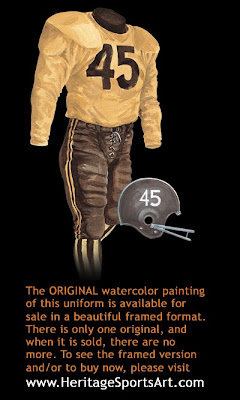
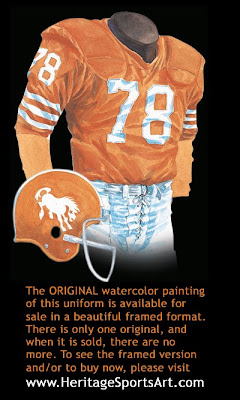

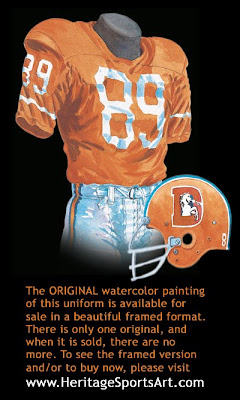
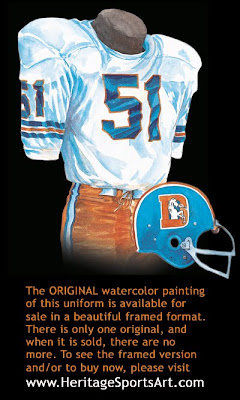


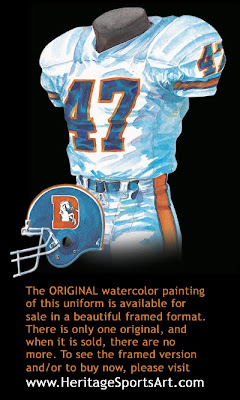




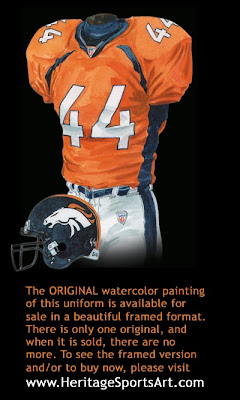
No comments:
Post a Comment
Thank you for taking the time to add a comment - all input is welcome, especially the constructive kind! All the best - Scott